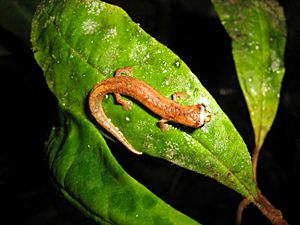Walker's salamander facts for kids
Quick facts for kids Walker's salamander |
|
|---|---|
 |
|
| Conservation status | |
| Scientific classification |
Walker's salamander (Bolitoglossa walkeri) is a special type of salamander found only in Colombia. It belongs to a group of salamanders called Plethodontidae, which are known for not having lungs. Instead, they breathe through their skin and the lining of their mouths.
This small creature lives in wet, cool mountain forests. It is an endemic species, meaning it naturally lives in only one specific area and nowhere else in the world. Walker's salamander is an important part of its forest home.
Contents
About Walker's Salamander
What Does It Look Like?
Walker's salamander is a small amphibian, usually only a few centimeters long. Like many salamanders, it has a sleek body, short legs, and a tail. Its skin is smooth and moist, which helps it breathe. The exact colors can vary, but they often have shades of brown or reddish-brown, helping them blend in with their forest surroundings.
Where Does It Live?
This salamander lives in the Andes Mountains of Colombia. Its natural habitat is described as subtropical or tropical moist montane forests. This means it prefers forests that are high up in the mountains, where it's often cloudy, rainy, and humid. These forests are full of moss, ferns, and decaying leaves, which provide perfect hiding spots and food sources for the salamander. They need a lot of moisture to keep their skin wet so they can breathe properly.
What Does It Eat?
Walker's salamander is a carnivore, meaning it eats other small creatures. Its diet mainly consists of tiny invertebrates found in the forest leaf litter. This includes insects like ants, mites, and small spiders. They use their quick, sticky tongues to catch their prey. By eating these small creatures, they help control insect populations in their ecosystem.
Life Cycle
Like other amphibians, Walker's salamanders start their lives as eggs. Unlike many frogs or other salamanders that lay eggs in water, Bolitoglossa salamanders often lay their eggs on land, usually in moist, hidden places like under logs or in damp soil. The young salamanders hatch directly from the eggs as miniature versions of the adults, without a tadpole stage. This is a special adaptation that helps them live entirely on land, even though they need a very moist environment.
Why Is It Important?
Every species plays a role in its ecosystem, and Walker's salamander is no exception. As a predator of small insects, it helps keep the forest healthy. Its presence also indicates a healthy and balanced forest environment. Scientists study these unique creatures to understand more about biodiversity and how different species adapt to their specific habitats.
Conservation Status
Walker's salamander is currently listed as "Near Threatened" (NT) by the International Union for Conservation of Nature (IUCN). This means that while it is not critically endangered right now, it could become threatened in the near future if conservation efforts are not continued.
Threats to Their Survival
The main threats to Walker's salamander are:
- Habitat Loss: Forests where they live are sometimes cut down for farming, logging, or building. This destroys their homes and makes it harder for them to find food and shelter.
- Climate Change: Changes in weather patterns, like less rain or higher temperatures, can make their moist forest homes too dry for them to survive.
- Pollution: Pesticides and other chemicals used in nearby areas can wash into their habitats and harm them.
What Can Be Done?
Protecting Walker's salamander involves protecting its forest habitat. This includes:
- Creating and maintaining protected areas where forests cannot be cut down.
- Encouraging sustainable farming practices that do not harm nearby ecosystems.
- Educating people about the importance of amphibians and their habitats.
- Researching more about these salamanders to understand their needs better.
By working together, we can help ensure that Walker's salamander and its unique mountain home are protected for future generations.
See also
 In Spanish: Bolitoglossa walkeri para niños
In Spanish: Bolitoglossa walkeri para niños


